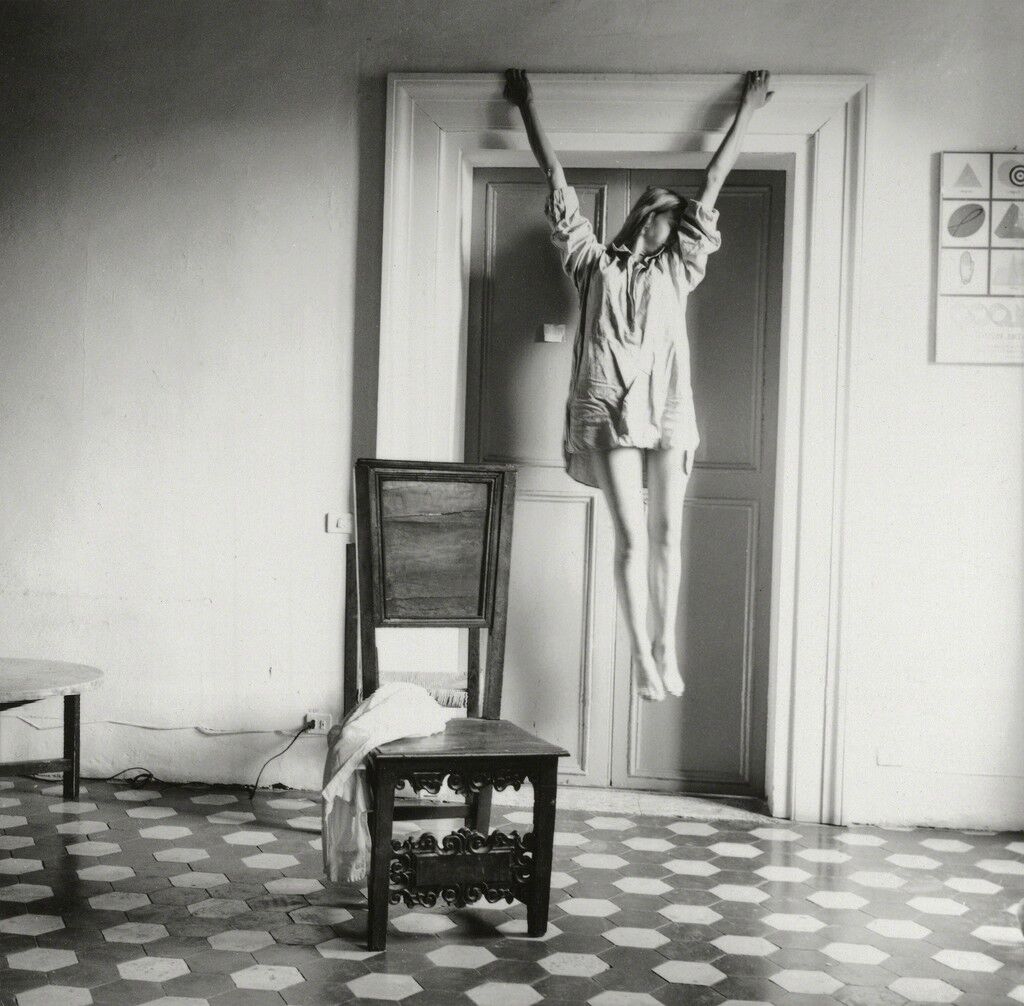American photographer Francesca Woodman (1958-1981) is known for her black-and-white self-portraits. Her self-portraits often feature her nude body composed in a way that resembles Surrealism. Woodman's photographs also often use slow shutter speed and double exposure so that she can create a sense of movement. Because Woodman's work was so innovative for the time, it did not gain as much attraction as she had hoped during her life. It wasn't until after her tragic death at the age of 22 that her photographs began attracting any attention, but even that attention seemed to miss the point of Woodman's artwork. Instead of seeing the photographs for what they were, they were instead used as "evidence of female anguish and a spiral toward terminal despair" (Rexer 70). Woodman's work, however, is about so much more than her own inner turmoil.
Francesca Woodman, From Space2, Providence Rhode Island 1976
Even though Woodman often uses female nudity in her photographs, her pieces are not intended to be overtly sexual. As is seen in From Space2, Woodman uses her faceless female figure to interact with the space around her. With the wallpaper held up in front of her body, her nude figure seems to become part of the wall in the background. Rather than focusing on the female body, the focus becomes the relation between the body and the space around it. The way that the female body so easily fades into the background could be interpreted as the way that women in society are also often forced to hide in the background.
Francesca Woodman, Untitled, Rome, Italy, 1977-78
Woodman used slow shutter speed often as a technique to play with motion. As seen in Untitled, Rome, Italy, 1977-78, her legs look blurry because of this technique. This invokes a sense of motion which helps to convey a story in the image. Woodman's delicate grip on the door frame as well as the large space between her feet and the floor makes it look like she is floating. She looks ghost-like. The fact that she is hiding her face as well creates a figure that the audience can project upon. Instead of the photo reflecting Woodman herself, the floating figure can be read as a generic female figure.
Francesca Woodman, Self-deceit #1, Rome, Italy, 1978
Another big motif used in Woodman's photographs are mirrors. In the photograph Self-deceit #1, Woodman uses the mirror to reveal what would not be seen if it were not there. In this case it is Woodman's face. We don't actually seen Woodman's face in this image, however, only a partial reflection. This can show the ways in which her self-portraits are not actually her, but a reflection of her self-discovery. The nude figure turning the corner from the darkness into the light and seeing her own reflection in the mirror could be read as the way in which Woodman, or any other woman for that matter, has discovered her true self and come to accept it.
Francesca Woodman, Untitled, Providence, Rhode Island, 1976
Many of the ways in which Woodman's photographs are composed makes the figure seem ghost-like and eerie. In the photograph Untitled, Providence, Rhode Island, 1976 it is not the living figure that is ghost-like, but more so the absence of the figure that created the print on the floor. This creates an interesting dynamic between the nude figure sitting and the absent figure on the ground.
Francesca Woodman, Untitled, Rome, Italy 1977-78
The same dynamic of two different figures, one ghost-like and one not, in a single photograph continues in Woodman's photo Untitled, Rome, Italy 1977-78. This time, however, the seated figure's face is shown. Reading her expression, she seems unaware of the ghost-like figure behind her. This in turn could be read as acceptance of one's mortality. A darker thought maybe, but thought-provoking nonetheless.
Immediately following Francesca Woodman's death, her work was misconstrued as depressing reflections of a troubled mind. It was not until more recently when galleries and museums began showcasing her work that the true stories of her and work were able to shine.
Bibliography
“Francesca Woodman.” Artnet, www.artnet.com/artists/francesca-woodman/.
“From Self-Portrait to Selfie: Memes Come True.” The Critical Eye: Fifteen Pictures to Understand Photography, by Lyle C.. Rexer, Intellect Books, 2019, pp. 68–75.
Seymour, Tom. “On Being an Angel: Finding Francesca Woodman in the Otherness of Her Self-Portraits .” British Journal of Photography, 12 Feb. 2016, www.bjp-online.com/2016/01/on-being-an-angel-francesca-woodman-foam-amsterdam/.
Tate. “Finding Francesca – Look Closer.” Tate, www.tate.org.uk/art/artists/francesca-woodman-10512/finding-francesca.
Wolkoff, Julia. “Francesca Woodman's Early Death Haunts Her Groundbreaking Images.” Artsy, 22 Aug. 2018, www.artsy.net/article/artsy-editorial-reevaluating-francesca-woodman-early-death-haunts-groundbreaking-images.





Comments
Post a Comment